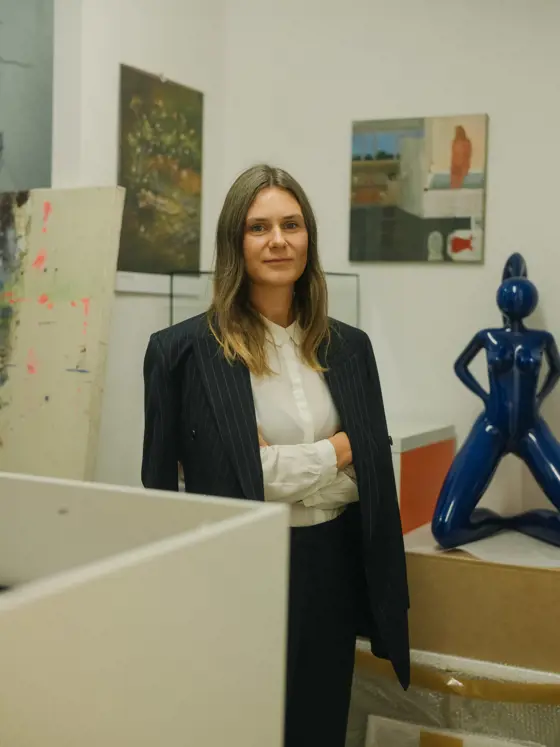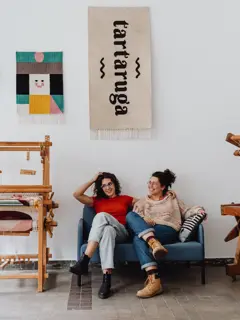Warsaw Gallery Weekend (WGW) is an event we look forward to all year. During the last weekend of September (28th of September to 1st of October), visitors can view contemporary art exhibitions at 37 independent galleries scattered around Warsaw. We talk to the person who knows all about WGW. Joanna Witek-Lipka, director of WGW, has been running the event for the past five years.

“There’s something magical about working with contemporary art – you get to interact with incredibly sensitive and imaginative people,” she says. “Despite all kinds of difficulties that come with putting on events, it’s an extremely satisfying job. Everyone on my team knows what they’re doing, we all know WGW inside out, and we’re well aware of what areas we need to develop further. This year, we're focusing on greater inclusivity. Some events will be translated into Polish sign language, and we’ll also ensuring better access for people with disabilities.”

The 13th edition of WGW is about to start, and it appears to be a monumental undertaking.
Joanna Witek-Lipka: Indeed. But it all started with a passion for art, at a time when the Warsaw gallery market was in its infancy. Over the following dozen or so years, the event has drawn in many galleries and attracted the interest of a large audience, including both professionals and people who don’t regularly visit contemporary art venues. This year, WGW features a record number of galleries – 37, including two invited from abroad. It’s an important event in this part of Europe and one of the most important events in the Gallery Weekend series, alongside Berlin, Brussels, Paris, London and Barcelona. This formula is a response to the tedium of art fairs, where galleries present a cross-section of their artists and latest works for sale, rather than focus on comprehensive presentations of their artists’ work. What’s unusual about WGW is that it only features independent galleries, and they all present especially curated solo or group exhibitions by newcomers or well-established artists.
What do you mean by independent and what conditions should an art gallery meet in order to take part in WGW?
I refer to galleries run by private individuals, foundations, or associations that regularly present exhibitions and have an established programme and a curator who decides what to show in the gallery. For us, it matters whether gallery owners participate in shaping artists’ careers – are they engaged in finding new talent? Do they work to ensure that artists’ work is shown at not only private, but also public institutions? A good gallerist seeks out talent and works to make it recognizable among a wider audience. Galleries that present both recognized artists and newcomers tend to be the most successful.
How can a first-time visitor navigate the WGW?
First, find the closest art gallery in your vicinity. There, you will find a flyer/map, which also serves as a mini-catalogue with information about where other galleries are. Then you can plan an interesting walking tour, during which you can also admire the architecture that’s usually easy to overlook. For example, for the past few years, Galeria Asymetria has been organizing exhibitions in Złota Milonga, hidden in Krasiński Park in the very centre of Warsaw. It’s a fascinating building with a spectacular roof; it houses an Argentine tango school. You can also use the online map. It might be useful, because some galleries are in quite unusual places. Gunia Nowik Gallery, Wschód, Stereo, Szara, and Wanda all occupy premises in tenement buildings around Pięć Rogów Square – Warsaw’s new contemporary art hotspot. Another good example is Le Guern, located in Saska Kępa in a beautiful tenement house with a magnificent garden at the back.


How can we prepare for WGW? Those unfamiliar with the art world may find it quite intimidating.
Not at all! Not all visitors know a lot about art. You don't have to know much about it to experience it. Yes, self-referential art can be more challenging, but in general art is all about experiencing emotions, about something happening when we encounter a painting, sculpture or during a performance. When it comes to WGW, we can be certain that both the curator and the artist will be present – we don't have to arrange a tour. We can get to know the authors of artworks and the context of exhibitions – and this is most important when it comes to contemporary art. Sometimes all we need is a wake-up call, an impulse to look at something from a different perspective.
Would it be worth having a guide?
I think so, but you can do without one. Before I became the director of WGW, I attended the event for many years. The more I went, the more I understood – I was able to notice certain recurring threads. I gradually learned how to look at art. I should add that PURO Hotel organizes great art walking tours.
Can we learn something about the condition of contemporary art after visiting 37 art galleries?
Visiting WGW for several years in a row would be enough to learn about the different galleries, to know which artists are recognized today. Although galleries taking part in WGW are all commercial galleries, i.e. the art they show is for sale, the educational dimension of the event is very important to us. Because of their commercial character, the galleries’ offer is available to the public at all times. As each will prepare a few exhibitions or meetings or performances during the year, we get access to an entire sea of free culture, and this is just in Warsaw. Of course, there are commercial galleries in every other major urban centre in Poland, and there will be more and more of them.

Which galleries are WGW pioneers and newcomers?
The pioneers are Raster, Fundacja Galerii Foksal, Leto, Piktogram, Stereo, BWA, Monopol, Dawid Radziszewski, Lokal 30, and Le Guern – all galleries with a long history. But every year we also invite some that are just starting out. This year, WGW will feature Wanda, Turnus and Piana, as well as two galleries from Kyiv, Ukraine: The Naked Room and Voloshyn, whom we helped find suitable exhibition spaces in Warsaw. The Naked Room will exhibit at Warszawskie Obserwatorium Kultury next to Monopol Gallery and Voloshyn at Metropolitan at Piłsudski Square.
How do artists find these lively interactions with the audience?
These interactions are essential. Sometimes answering the most simple questions is most difficult, and such encounters bring on additional self-reflection and broaden one’s perspective. In her recent film, “How Much for Art?”, Monika Misztal said – and this was rather touching – that artists in Poland strive to exhibit at WGW. We welcome up to 12,000 people during a single weekend, and this number is growing every year. Queues line up in front of galleries, but that doesn’t discourage visitors. Every year, I’m surprised by the number of people queuing to see performances because, in terms of reception, painting is the easiest, while performance can be quite intimidating. So this year, many galleries taking part in WGW will host special events focusing on performance throughout October. We can develop this part of the programme thanks to the support of the City of Warsaw, Hestia Artistic Journey Foundation and ING Foundation of Polish Art.
Finally, please tell us about your work organizing the festival. This is one of your two main activities. I imagine you’ve been working on WGW all year?
For the most part, my job is to find funding and build partnerships – I do this all year. Beyond that, I deal with recruitment, programme board meetings, and programming of accompanying events. In May, work begins in earnest, with a focus on the programme. A dozen people work behind the scenes. There are more and more applications each year – over 60 galleries have applied this year. We chose those that are best at shaping the contemporary art world. It’s not impossible to get in to exhibit as part of WGW, but the competition is really tough. We want to offer our audience the best possible programme.

Joanna Witek-Lipka, born in 1987 in Warsaw. A lawyer by education, since 2012 she has been involved in cultural management and the production of artistic events, art-branding, and branding projects. She’s worked with partners including Hermès, Meta, Campari, Suzuki, PKO SA, VRG, ING, Puro, Raffles Europejski, White & Case, NYX, and Hestia Artistic Journey. Since 2014, she’s worked with Edgar Bąk Studio. She’s the executive producer (since 2019) and director (since 2020) of Warsaw Gallery Weekend.
Similiar Articles

- Trend
- Poland
Coffee Spots Polska is back

- Trend
- Poland
Exhibition: "From the Ashes" at Zachęta

- Trend
- Poland
